Want to know how to make home-made pasta? In this post you will find everything you need to prepare your own batch of fresh pasta, how to pair it with different sauces. You will also learn how to color them using different ingredients, different pasta varieties to choose from and great tips to cook a delicious dish. Also you will find some pasta recipes below.
⇓ You may also listen to the instructions by pressing the play button below:
- Dried Pasta Types
- Flavored Pasta
- Pairing Sauces With Pasta
- So Which Sauce for Which Pasta?
- Making Basic Pasta Dough
- Using a Pasta Machine
- How to Make Homemade Pasta
- Flavoring and Cooking Pasta
- Nutrients and Calories in Dried Pasta
Dried Pasta Types
Pasta is simply the Latin word for “paste”, the flour-and-egg-based dough from which it is made. Although a staple of Italian cooking, pasta is also widely used in every corner of the world and has much in common with Chinese noodles, which filtered from China via the Middle Eastern trade routes.
In Italy today there are countless varieties of pasta, from flat sheets of lasagne and ribbon noodles to pressed and molded shapes specifically designed to pocket substantial amounts of the sauce with which they are served. Dried pasta, made from hard durum wheat, is a good standby and keeps for weeks in an airtight container. Fresh pasta has a better flavor and texture, but will only keep for a couple of days, although it can be successfully frozen. Fresh pasta is usually made by hand, using plain white flour enriched with eggs. Commercially, made fresh pasta is made with durum wheat flour, water and eggs. The flavor and texture of all fresh pasta is very delicate, so it is best suited to creamier sauces.
Pasta is a wonderfully simple and nutritious staple food. Both fresh and dried pasta can be bought flavored with tomato, olive, spinach or mushroom paste. Black pasta, made with the addition of squid ink, is increasingly popular. Pasta is easy to make at home if time is allowed for chilling the fresh dough. Rolling it can be done effortlessly using a pasta machine.
Pasta comes in a huge range of shapes, sizes and lengths, falling into the basic categories of strands, ribbons, tubes and shapes. Which one you choose will depend mainly on the sauce you are serving with your pasta. Strands (such as spaghetti) and ribbons (such as fettuccini) are ideal with light and oil-based sauces, which coat the strands evenly. Tubes (such as penne) or shapes (such as conchiglie) go well with chunky or meaty sauces, as their insides catch the sauce. But these are just guidelines, not a set of rules -you should choose pairings that you like or that simply suit your mood.
Strands and Ribbons
Long pasta, known as ‘pasta lunga’, comes either as long strands (hollow or solid) or as flat ribbons, called ‘fettucce’.
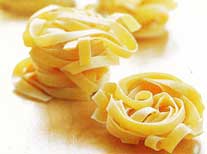
Strands: spaghetti, spaghettis, bucatini – which are hollow.
Ribbons: tagliatelle, linguine, tagliolini, fettuccine, pappardelle.
Tubes and shapes are either plain or ridged – ‘rigati’. The ridges help the sauce cling to the pasta.
Tubes and Shapes
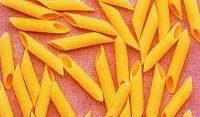
Tubes: penne, chifferi, rigatoni, macaroni.
Shapes: fusilli, conchiglie, farfalle, orecchiette, gemelli.
Pasta for Soups
Very small shapes are ideal for soups, as they look very pretty and delicate and don’t dominate the soup.

Soup pasta: anellini, fedelini, stelline, alfabetini, ditali.
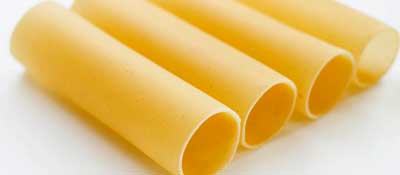
Pasta for Baking: Lasagne are flat sheets of pasta, layered with sauce in baked dishes. Cannelloni are large tubes for stuffing and baking.
Flavored Pasta
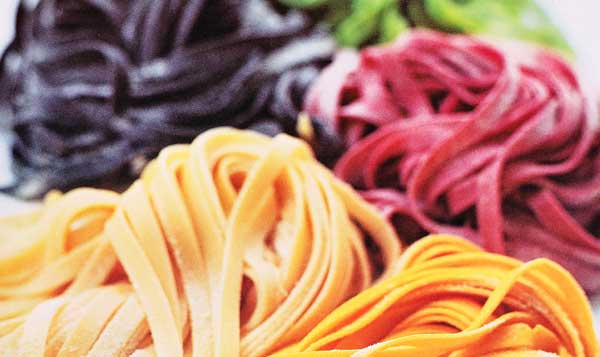
Pasta flavoured and coloured with spinach, tomato or squid ink are the most common, although beetroot, basil and saffron flavour are also available in many shops. Scroll down to see different ways to flavor a pasta.
Pairing Sauces With Pasta
Given the variety of sauces and the similar abundance of pasta types and shapes that are available, it can often be difficult to choose which sauce to combine with which type of pasta. Although the choice is very much down to the individual, here are some handy tips to help you on your way to creating a combination that would make the Italians proud.
Some sauces take no time at all to prepare, involve very little cooking and are more like dressings than sauces. In fact, the word condimento (dressing) comes to mind; the Italians often use It rather than salsa or sugo (sauce) when talking about pasta. Other sauces, particularly meat sauces, can be prepared in advance (a plus when having friends over), then reheated when required. Many have store-cupboard equivalents, which are great for unexpected guests and ‘home-from-work, straight-onto-the-table’ meals. All are easy to make – the choice is yours.
So Which Sauce for Which Pasta?
Homemade pasta made with eggs and wheat flour comes from the north of Italy. The sauces that are served with it are, on the whole, rich meat- and dairy-based sauces enhanced with Parmesan cheese, reflecting the rich agricultural heritage of the north. Spaghetti made with durum wheat flour, cultivated in the more arid south, comes originally from Naples. Myriad homemade pasta shapes, made with this flour, water and the spirit of invention brought by necessity, are set in the traditions of the cooking of the south.
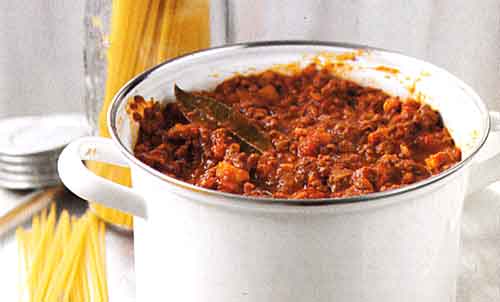
There is a simple rule to follow when deciding which pasta to serve with which sauce. Egg pasta, long or short, is perfect for sauces based on dairy food and meat, while spaghetti and other pasta shapes made with durum wheat are more suited to the lighter, olive-oil-based sauces made with fish and vegetables.
Cream and meat sauces also go well with ridged tubes, especially if there are small delicious bits to get trapped inside. Ridged pasta is particularly good for creamy sauces, as the sauce binds itself to the ridges.
One last word – don’t be afraid to try different sauces with different pastas and find out what you like!
Making Basic Pasta Dough
Nothing beats homemade pasta – not even shop-bought ‘fresh’. A mixture of 50% Italian ‘00’ flour and 50% Farina di Semola (pale yellow, finely ground, hard durum wheat flour for making pasta and some breads – fine Farola baby food is semolina flour) works particularly well. This mixture of soft and hard wheat flours gives the dough a firmer texture.
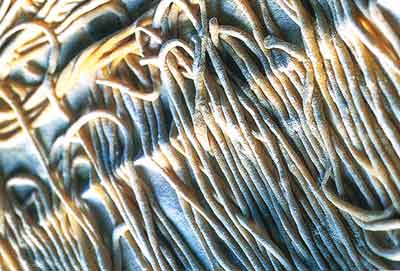
You may also use strong white bread flour. The dough must not be too soft – it should require some serious effort when kneading! However, too much extra flour will make the pasta too tough to handle (or put through the pasta machine) and when cooked, taste floury. Generally allow one egg to 100 g flour per portion for a main course. It’s best to make a large batch in one go and freeze it once cut and shaped.
To make the pasta in the traditional way, sift the flour onto a clean work surface and make a well in the center with your fist. You will need:
- 200 g Italian ‘00’ flour or 100 g Italian ‘00’ flour and 100 g Farina di Semola
- 2 medium eggs
- 1 tablespoon olive oil
- A pinch of sea salt and freshly ground black pepper
(Makes approximately 500 g)

STEP 1: Break the eggs into the well and add a pinch of salt and freshly ground black pepper and the oil.
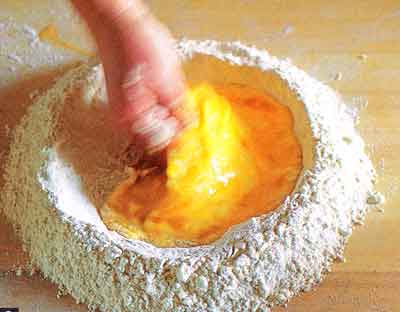
STEP 2: Gradually mix the eggs into the flour with the fingers of one hand, and bring it together into a firm dough. If the dough feels too dry, add a few drops of water; if too wet, add more flour. You will soon grow accustomed to how the dough should feel once you’ve made it a few times.

STEP 3: Knead the pasta until smooth, lightly massage it with a hint of olive oil, pop into a plastic food bag and allow to rest for at least 30 minutes before attempting to roll out. The pasta will be much more elastic after resting.
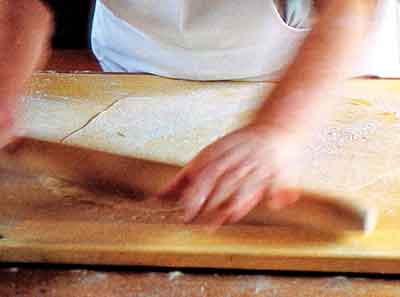
STEP 4: Roll out by hand with a long wooden rolling pin or use a pasta machine.
TIPS
The Italian way is ALWAYS to toss the cooked, hot pasta with the sauce before serving.
Using a Pasta Machine
Feed the rested dough 4-5 times through the widest setting of a pasta machine, folding into three each time, and feeding the open ends through, the rollers to push out any air. This will finish the kneading process and make the pasta silky smooth. Next, pass the pasta through the machine, starting at the widest setting first, then reducing the settings, one by one, until reaching the required thickness. The pasta sheet will become very long – so if you are having trouble, cut it into two and feed each half through separately.
Generally the second-from-last setting is best for tagliatelle; the finest is for ravioli or pasta that is to be filled.
Once the required thickness is reached, hang the pasta over a broom handle or the back of a chair to dry a little – this will make cutting it easier in humid weather, as it will not be so sticky. Alternatively, dust with a little flour and lay out on clean tea towels.
Next, pass the pasta through the chosen cutters (tagliolini, tagliatelle, etc) then drape the cut pasta over the broom handle again to dry further, until ready to cook. Alternatively, toss the cut pasta lightly in flour (preferably semolina flour) and lay out in loose bundles on a tray lined with a clean tea towel. Use as soon as possible before it sticks together.
How to Make Homemade Pasta
How to Make Tagliatelle:
Roll the dough out thinly on a lightly floured surface or using a pasta machine.

STEP 1: Roll or fold one end loosely towards the center of the sheet, then do the same with the other 80 that they almost meet in the middle. Lift one folded side on top of the other – do not press down on the fold.

STEP 2: Working quickly and deftly with one motion, cut into thin slices with a sharp knife, down the length of the folded pasta.
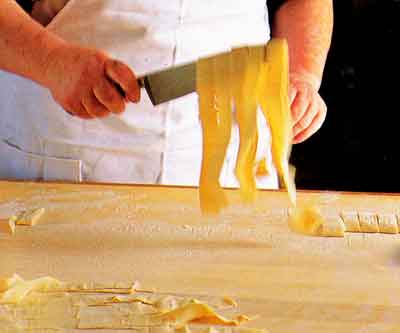
STEP 3: Immediately unravel the slices (or they will stick together) to reveal the pasta ribbons -you can do this by inserting the back of a large knife and shaking them loose. Hang to dry a little before cooking or… (next step 4)

STEP 4: Dust well with semolina flour and arrange in loose ‘nests’ on a tray lined with a clean tea towel.
How to make Pappardelle:
Roll the dough out thinly on.a lightly floured surface or using a pasta machine. Using a fluted pastry wheel, cut into wide ribbons. Hang up to dry a little before cooking.
How to make Tortellini:
Roll the dough out thinly on a lightly floured surface or using a pasta machine. Using a round biscuit cutter, stamp out rounds of pasta. Pipe or spoon your chosen filling into the middle of each round. Brush the edges with beaten egg and carefully fold the round into a crescent shape, excluding all air. Bend the two corners round to meet each other and press well to seal. Repeat with the remaining dough. Leave to dry on a floured tea towel for about 30 minutes before cooking.
How to make Ravioli:
Halve the dough and wrap one half in clingfilm. Roll the pasta out thinly on a lightly floured surface or using a pasta machine. Cover with a clean tea towel or clingfilm and repeat with the rest of the dough. Pipe or spoon small mounds (about 5 ml/1 teaspoon) of filling in even rows, spacing them at 4-cm intervals across one piece of the dough. Using a pastry brush, brush the spaces of dough between the mounds with beaten egg. Using a rolling pin, lift the remaining sheet of pasta over the mounds. Press down firmly between the pockets of filling, pushing out any trapped air. Cut into squares with a serrated ravioli/pastry cutter or sharp knife. Transfer to a floured tea towel to rest for about 1 hour before cooking.
Flavouring and Cooking Pasta
Spinach Pasta: Follow the Basic Pasta Dough recipe. Sift the flour onto a clean work surface. Next, blend the flour with 150 g frozen leaf spinach (cooked and squeezed to remove as much moisture as possible), a pinch of salt, some pepper and 2 medium eggs, until very smooth, and continue as per the Basic Pasta Dough method, from point.
Tomato Pasta: Add 2 tbsp (tablespoons) tomato purée or sun-dried tomato paste to the well in the flour. Use 1 large egg instead of 2 medium ones.
Beet Pasta: Add 2 tbsp grated cooked beetroot to the well in the flour. Use 1 large egg instead of 2 medium ones.
Saffron Pasta: Soak a sachet of powdered saffron in 2 tbsp hot water for 15 minutes. Use 1 large egg instead of 2 medium ones and whisk in the saffron water.
Herb Pasta: Add at least 3 tbsp finely chopped fresh green herbs to the well in the flour. Or blanch the herbs, dry, then chop before the time comes to use them.
Black Squid ink Pasta: Add 1 sachet of squid ink to the eggs before adding to the flour. A little extra flour may be needed.
How to Cook: Cooking times for fresh and dried pasta vary according to the size and quality of the pasta. The only way to check is to taste it (and to follow the packet instructions). However, the basic method of cooking remains the same. Wholemeal pasta will always take a little longer to cook than white pasta.
Throw the pasta into a large saucepan of boiling, salted water – as a guide, you will need about 4 liters water and 3 tbsp salt for every 375-500 g fresh or dried pasta. It is this large volume of water that will prevent the pasta from sticking together. Stir once or twice – if you have enough water in the pan and you stir the pasta as it goes in, it shouldn’t stick.
DO NOT COVER, or the water will boil over. Quickly bring the pasta back to a rolling boil, stir and boil until it is ‘al dente’, or firm to the bite. It should not have a hard center or be soggy and floppy. Calculate the cooking time from the moment the pasta starts to boil again and have a colander to hand for draining.
Next, drain the pasta, holding back 2-3 tbsp of the cooking water, returning the pasta to the pan (the dissolved starch in the water helps the sauce cling to the pasta). Dress the pasta straight away with the sauce directly in the pan. Serve immediately.
Nutrients and Calories in Dried Pasta
| Calories: 211 Kcal Total Fat: 0.9 g Saturated Fat: 0.2 g Trans Fat: 0 g Cholesterol: 0mg Carbs: 43 g 7% Sugars: 1.5 g Protein: 7.4g 0% Vitamin A: 0% Vitamin C: 1.2% Calcium: 10% |

